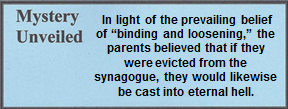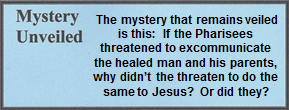11.02.23 Jn. 9:18-23
PHARISEES QUESTION THE HEALED MAN’S PARENTS.
18 The Jews did not believe this about him—that he was blind and received sight — until they summoned the parents of the one who had received his sight.
19 They asked them, “Is this your son, the one you say was born blind? How then does he now see?”
20 “We know this is our son and that he was born blind,” his parents answered. 21 “But we don’t know how he now sees, and we don’t know who opened his eyes. Ask him; he’s of age. He will speak for himself.” 22 His parents said these things because they were afraid of the Jews, since the Jews had already agreed that if anyone confessed Him as Messiah, he would be banned from the synagogue. 23 This is why his parents said, “He’s of age; ask him.”
As stated previously, what both the leading Pharisees and Sadducees missed, what they did not learn from the destruction of Solomon’s Temple and the exile, is that God cares more about obedience, steadfast love, justice, righteousness, and humility than sacrifices, festivals, offerings, and assemblies.[1]
The indignant Pharisees said the healed man and any other followers of Jesus would be “banned from the synagogue.” Nothing was more important to a Jewish person than the synagogue. This was a powerful response because it was the local community center, the center of social and religious life outside of the temple. But what religious rule did these people break which would cause the religious leaders to ban them from the synagogue?
Just as the Jews had prioritized the 613 commandments of the Torah,[2] they had also established 24 violations that would result in excommunication, and prioritized them as well. One of those regulations was decreed, for the necessity of the time.[3] In essence, this was a “catch-all” reason that could be applied to anyone, at any time, for any reason. The parents and their healed son were probably threatened with violating this decree.[4] To be excommunicated or “put out” was a horrible social stigma. Scholars agree that there were three levels of excommunication, but slightly different in the length of each one (see footnotes). In first century Judaism there were three levels of excommunication as follows:
- The lightest level was the neziphah or n’zifah (rebuke) in which a person was removed from seven to thirty days.[5] An individual such as the synagogue president could impose this penalty.[6] A New Testament example is found in 1 Timothy 5:1.
- A moderate level of punishment was the niddui or niddul (casting out; rejection) of the congregation.[7] This action required the decision of three persons and the excommunication lasted for an additional thirty days. A New Testament example is found in Titus 3:10.
- The most severe form of excommunication was the cherem, which resulted in the excommunicated person being treated as if dead.[8] A New Testament example is found in Matthew 18:15-20. Such treatment included the following: [9]
a This person was not permitted to be in a group of ten or more men. Obviously that meant he could not attend a synagogue service.
b.This person was not permitted to engage in any public prayers or services.
c.The public had to keep at least four cubits of distance from him.
d.No conversations were to be held with him.
e.Whenever he died, stones were to be thrown on his coffin and mourning for him was forbidden.[10]

The context of John 9:18-23 appears to be that the excommunication of the man healed by Jesus was a moderate one. Clearly, there were three or more individuals who challenged Jesus and the healed man, and also had the authority to excommunicate. Yet to experience the healing was the most exhilarating one, one that demonstrated that God still loved them.
This miracle polarized the differences between the followers of Jesus and those who opposed Him. Common belief was that when the messiah came, he would perform three kinds of messianic miracles that would unquestionably demonstrate His Messiahship: He would
- Heal a Jewish leper,
- Cast a demon or demons out of a mute or deaf person (In various Inter-Testamental Jewish writings, the advent of the Messiah meant that evil would be defeated.[11]), and
- Heal someone who was born blind. [12]
Jesus had now performed the last of the three and the leading Pharisees were scathing mad. But there is a mystery that remains as such – a mystery! If the Pharisees threatened to excommunicate the man who was healed or his parents, why didn’t they threaten to excommunicate Jesus? Or was Jesus excommunicated and the gospel writers believed there were other matters more important to record in their gospels than this?

Finally, in today’s Western culture it is nearly impossible to comprehend the social stigma that was associated with first century excommunication. Whenever it occurred, the chief authorities of the local synagogue read the name of the excommunicated person, the length of time the sentence was to be in effect, and the reason for the judgment. The healed man was threatened with excommunication, which was also a threat to his parents. However, there is no record that this form of punishment was never threatened upon Jesus. Is it possible that Jesus was either threatened with excommunication, or was excommunicated from some local synagogues, and the gospel writers never wrote of it?
[1]. Jer. 7:21-23; Hos. 6:6; Amos 5:21-24; Mic. 6:6-8.
[2]. The 613 laws were observed only during the times of the tabernacle or temple. Today, only 271 of those Mosaic commands can be observed. See Parry, The Complete Idiot’s Guide to the Talmud. 221.
[3]. Lightfoot, A Commentary on the New Testament from the Talmud and Hebraica. 3:345.
[4]. Lightfoot, A Commentary on the New Testament from the Talmud and Hebraica. 3:344-46.
[5]. Fruchtenbaum says this level of discipline had a limit of 7 days. Fruchtenbaum, The Jewish Foundation of the Life of Messiah: Instructor’s Manual. Class 16, page 6; Lang, Know the Words of Jesus. 320.
[6]. A ban from one synagogue did not mean likewise from all synagogues. Some scholars believe that Jesus may have been banned from some synagogues, which is why He did not teach in them in the latter part of His ministry. See Farrar, The Life of Christ. 310, 326.
[7]. Fruchtenbaum says this level of discipline was between 8 and 30 days. Fruchtenbaum, The Jewish Foundation of the Life of Messiah: Instructor’s Manual. Class 16, page 6; Lang, Know the Words of Jesus. 320.
[8]. Farrar, The Life of Christ. 309; Stern, Jewish New Testament Commentary. 184.
[9]. Vincent, Word Studies in the New Testament. 2:185.
[10]. Some historians believe that the more severe or restrictive demands (c,d,e) upon the excommunicated person do not reflect first century Jewish practices, but are of a later period.
[11]. 1 Enoch 55:4; Jubilees 23:29; Testament of Simeon 6:6; Testament of Judah 25:3; Testament of Moses 10:1, and the Testament of Solomon 20:16-17.
[12]. Research on the “Messianic Miracles” is credited to Dr. Arnold Fruchtenbaum, a Messianic scholar and director of Ariel Ministries in San Antonio, TX, formerly of Tustin, CA. For more information, see http://ariel.org/. Retrieved September 26, 2013. See also 06.03.08.V (Video), 06.01.03 and the comparison of Dead Sea Scroll fragments 4Q278 and 4Q521 with Luke 4:16-30 at 06.02.02; See also Fruchtenbaum, Messianic Miracles. 4; Fischer, The Gospels in Their Jewish Context. (Lecture on CD/MP3). Week 10, Session 2.